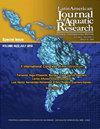温度、pH和光周期对富含梭状赖氨芽孢杆菌和波切能芽孢杆菌的淡水枝角虫Moina micrura培养物性能的影响
IF 0.8
4区 农林科学
Q3 FISHERIES
Latin American Journal of Aquatic Research
Pub Date : 2022-11-01
DOI:10.3856/vol50-issue5-fulltext-2932
引用次数: 0
摘要
淡水枝海(Moina microura)作为幼虫养殖的活饲料具有巨大的大众养殖潜力。本研究旨在评价益生菌梭状芽孢杆菌A1和芽孢杆菌S2在不同环境条件下对微乳杆菌种群密度、生长速度和产量的影响。设置了四种不同的温度(15、20、25和30℃)、pH值(4、6、8和10)和光周期(4L:20D、6L:18D、8L:16D和12L:12D)。监测各环境参数下的日孵育个体数12 d,测定微夜蛾种群密度和生长速度。同时,监测5只母鼠在不同环境参数下每天的新生儿数量,直到它们自然死亡。在试验第1天和第6天分别在5×104 CFU mL-1上添加两次益生菌。在30°C条件下,富B. pocheonensis S2的微微田鼠种群密度最高(10±0.2 ind mL-1),产仔数最高(132±6.43 ind),而在20°C条件下,其生长速率最高(0.1863±0.006 d-1)。在12L:12D的正常光照条件下,微夜蛾种群密度最高(10±0.3 mL-1),产仔数最高(129±4.58 ind),而在8L:16D的光照条件下,微夜蛾的生长速率最高(0.2879±0.0007 d-1)。pH为8时,富梭状乳杆菌A1的微微田鼠种群密度最高(11±0.8 ind mL-1),生长速率最高(0.5508±0.04 d-1),产仔数最高(129±4.36 ind)。结果表明,在温度为30°C,碱性pH为8 ~ 10,正常光周期为12L:12D的条件下,可使微褐藻S2的养殖产量最大化。本文章由计算机程序翻译,如有差异,请以英文原文为准。
Effects of temperature, pH, and photoperiod on the performance of a freshwater cladoceran Moina micrura culture enriched with Lysinibacillus fusiformis and Bacillus pocheonensis
The freshwater cladoceran Moina micrura has tremendous potential for mass culture as a live feed for larviculture. This study aimed to evaluate the efficacy of probiotics Lysinibacillus fusiformis A1 and Bacillus pocheonensis S2 in enhancing the population density, growth rate, and production of M. micrura under different environmental conditions. Four different temperatures (15, 20, 25, and 30°C), pH levels (4, 6, 8, and 10), and photoperiods (4L:20D, 6L:18D, 8L:16D, and 12L:12D) were set up. The daily number of individuals incubated under each environmental parameter was monitored for 12 days to determine the population density and growth rate of M. micrura. Meanwhile, the daily number of neonates from five females kept under respective environmental parameters was monitored until they died naturally. Probiotics were added individually at 5×104 CFU mL-1 twice during the first and sixth days of the experiment. M. micrura enriched with B. pocheonensis S2 at 30°C had the highest maximum population density (10 ± 0.2 ind mL-1) and the number of neonates produced (132 ± 6.43 ind), whereas treatment at 20°C had the best growth rate (0.1863 ± 0.006 d-1). M. micrura incubated with B. pocheonensis S2 at a normal photoperiod of 12L:12D had the highest maximum population density (10 ± 0.3 ind mL-1) and the number of neonates produced (129 ± 4.58 ind) while incubation at 8L:16D had the best growth rate (0.2879 ± 0.0007 d-1). M. micrura enriched with L. fusiformis A1 at pH 8 had the highest maximum population density (11 ± 0.8 ind mL-1), growth rate (0.5508 ± 0.04 d-1), and the number of neonates produced (129 ± 4.36 ind). Results recommend that a warmer temperature of 30°C, alkaline pH from 8 to 10, and a normal photoperiod of 12L:12D can be adopted for M. micrura enrichment with B. pocheonensis S2 to maximize its productivity for aquaculture use.
求助全文
通过发布文献求助,成功后即可免费获取论文全文。
去求助
来源期刊

Latin American Journal of Aquatic Research
FISHERIES-MARINE & FRESHWATER BIOLOGY
CiteScore
1.70
自引率
10.00%
发文量
44
审稿时长
4-8 weeks
期刊介绍:
Latin American Journal of Aquatic Research- LAJAR is the continuation of the journal Investigaciones Marinas (1970-2007) and is published since 2008 by the Escuela de Ciencias del Mar, Facultad de Ciencias del Mar y Geografía of the Pontificia Universidad Católica de Valparaíso. LAJAR is an “Open Access” journal that publishes in English language, original research articles, reviews and short communications on aquatic science, which contain the results of research conducted in aquaculture or in oceanic and coastal marine waters of Latin America.
The following topics are considered: Physical Oceanography, Chemical Oceanography, Marine Biogeochemistry, Marine Pollution and Toxicology, Marine Geology and Geophysics, Biological Oceanography, Fisheries and Aquaculture.
 求助内容:
求助内容: 应助结果提醒方式:
应助结果提醒方式:


